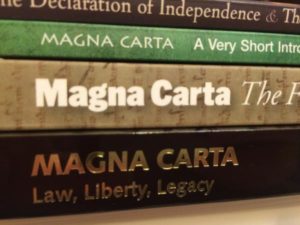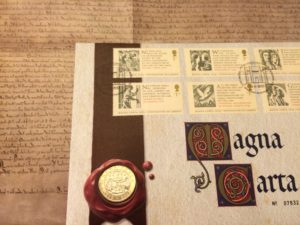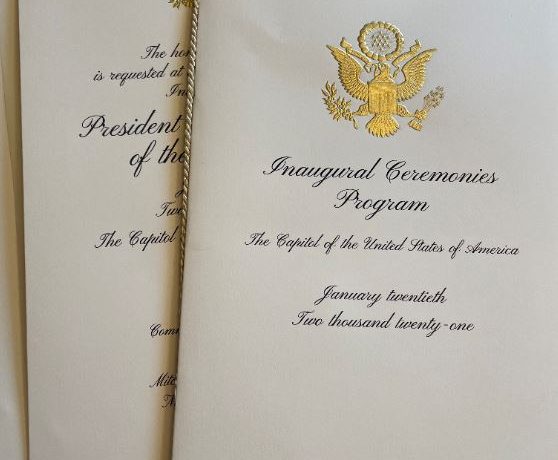The Magna Carta turns a young 800 years old today! That’s one hell of a long life for a rather interesting document. Originally planned as a peace treaty between the barons of England vs. evil King John (yes, he really was a psycho) and involving the Church (everyone was Catholic at this time) who deliberately squirreled away the document in various church archives in England and Ireland. No one person wrote it, but its suspected that the Archbishop of Canterbury had a hand in writing it and is mentioned at the beginning of it (the evil Sheriff of Nottingham, of Robin Hood fame, is also mentioned). So despite being a document that was suppose to lead to peace, in reality it led to war. A year later evil King John got the Church in Rome to nullified the document. However it was the first documented that attempt to limit the power of the sovereign (it was not a radical document, so these ideas must have been floating around for years). So on this day (June 15, 1215) in a field in Runnymede, England a document of historical significance was signed (maybe), but most likely stamped with the royal seal. Out of the 60+ clauses in the original 1215 version only about 2 or 3 are still in use today and while it was not for the common man/woman (lets be clear, it was to protect the rights and property of the barons and the Church of England), the idea or myth that it granted and guaranteed the rights of everyone remains to this day.
The National Achieves writes:
“Magna Carta was written by a group of 13th-century barons to protect their rights and property against a tyrannical king. It is concerned with many practical matters and specific grievances relevant to the feudal system under which they lived. The interests of the common man were hardly apparent in the minds of the men who brokered the agreement. But there are two principles expressed in Magna Carta that resonate to this day:
“No freeman shall be taken, imprisoned, disseised, outlawed, banished, or in any way destroyed, nor will We proceed against or prosecute him, except by the lawful judgment of his peers or by the law of the land.”
“To no one will We sell, to no one will We deny or delay, right or justice” (http://www.archives.gov/exhibits/featured_documents/magna_carta/).
Melvyn Bragg writes in The New Statesman:
“The charter spoke through the king to God and to the liberties of the Church. It enhanced the liberties of London, which the earls and barons had just captured. It bundled together a package of laws, most of which are of their time and have fallen off the page. Sadly for some, it said nothing about the rights of women, the welfare state, the trade unions or the euro.
Nor did it say anything about the right to parliamentary democracy, trial by jury or habeas corpus. But it can be argued that all these flowed from and were triggered by this document. And not only in this country, but as time went on, most powerfully in America, Australia, Canada, New Zealand and as a foundation stone in the constitution of India and elsewhere. After the Second World War, the UN set up the Universal Declaration of Human Rights, which Eleanor Roosevelt called a “Magna Carta for all mankind”.
Magna Carta has 63 clauses in abbreviated Latin. Two of them that are still on the statute book, numbers 39 and 40, could be said to have changed the way in which the free world has grown. “No free man shall be taken, or imprisoned, or disseised [his lands taken away], or outlawed, or exiled, or in any way ruined; nor will we go against him nor sin against him except by the lawful judgment of his peers, his equals and by the law of the land.” And, “To no one will we sell, to no one will we refuse or delay right or justice.” These two clauses have so far proved to be indestructible, though often defied. They came to apply to all men and then all women, and have elasticated their earliest purpose to become universal with a legendary, even mythical aura to them….
Magna Carta has become totemic. It is in the comedy of Tony Hancock, in the poetry of Kipling, never far from the front pages in a constitutional crisis. It was copied out by hand. Four copies are remaining and although one is badly damaged, there is not a blot on any of them. Those two clauses hit a nerve in societies all over the world. They have become sacred tablets” (http://www.newstatesman.com/politics/2015/06/it-made-us-free-melvyn-bragg-magna-carta).
And Tom Holland writes in The New Statesman:
“Not that its significance was evident at first. John was hardly the man to be bound by any agreement, no matter how solemnly sworn. It did not take him long to denounce Magna Carta. One year later, though, he was dead and in November 1216 the charter was reissued for the very first time in a desperate but ultimately successful attempt to rally support for John’s son, the nine-year-old Henry III. From then on it would repeatedly be confirmed by a succession of kings – 33 times in all. That its provisions grew steadily more obscure and incomprehensible to those who could be bothered to read them did not prevent Magna Carta from blazing in the imaginations of the English as an assurance that everyone, even the monarch, was under the law.
Since the 17th century, it has repeatedly been reinterpreted and reinvented by a whole succession of ideologues. Whether on opponents of Stuart absolutism or on the Founding Fathers of the United States, on the Chartists or on the lawyers who drew up the Universal Declaration of Human Rights, its influence has been immense. Even today, in our cynical and sceptical age, its potency remains undimmed. That Magna Carta never once mentioned democracy, equality or mutual respect did not prevent David Cameron, only last year, from declaring that it did. The inaccuracies scarcely matter. Every country needs its myths. That is why, 800 years on from the meeting at Runnymede, the uselessness of King John and all that resulted from it richly merits celebration” (http://www.newstatesman.com/politics/2015/06/tom-holland-magna-carta-was-forged-royal-failure).
Magna Carta info:
http://magnacarta800th.com/
http://www.archives.gov/exhibits/featured_documents/magna_carta/
http://www.bl.uk/magna-carta/articles/magna-carta-an-introduction
http://www.nbcnews.com/news/world/magna-carta-everything-you-need-know-about-800-year-old-n374246
http://www.bbc.com/news/uk-33139919




